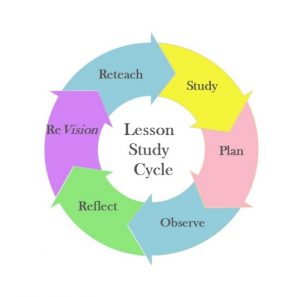By Vicki Collet, author of Collaborative Lesson Study: ReVisioning Teacher Professional Development
Professional development should be done by teachers, not done to them. It works best when it comes from the inside out, not from the top down. This idea is not new, and it is well-supported in research. However, teachers’ professional development is often provided, rather than supported. Why is this?
There seems to be a belief that “outside experts” have the silver bullet for improved instruction and student achievement. Billions of dollars have been spent on professional development in the United States, with a trend toward less-effective, shorter-duration trainings. But externally-imposed professional development is not “powerful enough, specific enough, or sustained enough” to effect lasting change (Fullan, 2007).
Real changes in instructional practice and student learning come about through professional development that is focused at the classroom level. As suggested by Thomas Guskey (2005), “The hard lesson we have gleaned from analyzing various waves of education reform is that it doesn’t matter what happens at the national, state, or even district level. Unless change takes place at the building and classroom levels, improvement is unlikely” (p. 40). No matter the grand imperatives and high-level planning, it is in the classroom where changes in teaching and learning can actually occur. So it makes sense to start there.
This is why professional learning communities (PLCs) matter. When PLCs are truly learning communities that regard teachers as professionals, professional development happens.
What is professional development? Let’s take a look at each of the words making up that phrase. Professional means being connected to a profession. A profession requires prolonged preparation and formal qualification. Because teachers have earned their teaching credentials, they are licensed professionals and should be regarded as such. This implies acknowledgement and respect for their knowledge and expertise about teaching. Professional development should regard teachers as professionals.
A close look at the idea of development is also enlightening. The root word, develop, has meanings with differing connotations that are worth considering. Something can develop or it can be developed. It’s important to think about who is doing the work. Is something developing from within or being developed from an outside source? Piaget and Vygotsky had ideas about child development that might shed some light. Piaget saw development as a natural unfolding. Vygotsky saw development as supported by tools and by “more knowledgeable others.” Professional development can occur through a blend of these ideas, a supported unfolding. This is the purpose of providing structures for professional learning communities. One such structure is collaborative Lesson Study.
In contrast to top-down reforms, Lesson Study is professional development that empowers teachers to drive improvement as they determine new ideas and methods to incorporate into their teaching. This job-embedded professional learning process has the potential to improve student achievement by looking closely at classroom practice.
Lesson Study is as straightforward as it sounds: the study of a lesson. However, Catherine Lewis, who learned about Lesson Study in Japan and has been instrumental in spreading its use in the United States, points out that during Lesson Study teachers improve lessons not as an end unto itself, “but as a way to deepen their own content knowledge, their knowledge of student thinking, their understanding of teaching and learning, and their commitment to improvement of their own practice and that of colleagues” (Lewis & Hurd, 2011, p. 24).
Lesson Study is not just about improving the single lesson; it is about improving the overall teaching/learning process in ways that are both generic and sensitive to the unique needs of learners. Through Lesson Study, teachers identify techniques that can be used in many situations.
In addition to elevating effective practices, research lessons also provide a window for considering students’ progress toward long-term learning goals. Teachers look closely at what children are learning, identify their misconceptions, and design ways to address them. Attention to individual students improves learning for all students. Lesson Study supports improvement that is adapted to individual students and local contexts while increasing teachers’ pedagogical and content knowledge, developing professional learning communities, and increasing teachers’ motivation and efficacy.
I’ve been supporting teachers in Lesson Study for over a decade, and I’ve seen dramatic results in teacher learning and student achievement. Here’s the model I use for Lesson Study:
Pretty simple, right? However, although teachers often plan and reflect together, they don’t often observe together a lesson they have collaboratively planned. And, I truly believe the observation piece is key. It takes forethought and creativity to make it happen. But it is worth the effort!
As Angela Duckworth points out in her book, Grit: Passion, Perseverance, and the Science of Success, “There are no shortcuts to excellence. Developing real expertise, figuring out really hard problems, it all takes time.” Lesson Study is not a quick fix. It is a structure that supports authentic, productive professional development, a cycle for instructional improvement that pays ongoing dividends.
Featured Image: Brainstorming session, public domain via Pixabay
Vicki S. Collet is an associate professor in the department of Curriculum and Instruction at the University of Arkansas. Prior to becoming a teacher educator, she worked as a district curriculum coordinator, instructional coach, interventionist, and elementary and secondary classroom teacher.

